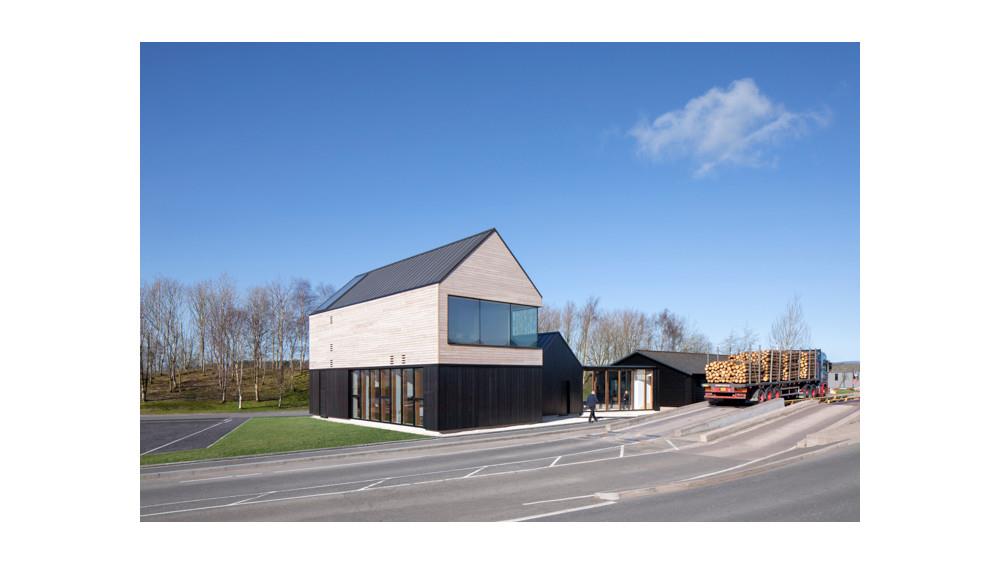

The Lockerbie site is the showcase sawmill within the James Jones Group.
It is the largest single site sawmill complex in the UK and the most technically advanced. As such, pre-pandemic, Lockerbie received a high number of visitors – including small groups of customer visits, customer training courses, academic institutions and industry events.
The idea for the building recognised the need to provide increased office accommodation, better visitor facilities, and the opportunity to host on-site training courses and industry meetings, which previously had to be conducted offsite.
The brief for the building was part functional and part aspirational. At a functional level, there was a requirement to provide office accommodation for up to 10 staff, a meeting room capable of holding up to 30 people theatre style, with the flexibility to hold classroom sessions and industry meetings and, in addition, a smaller meeting room, kitchen facilities and a reception area for visitors.
The building should obviously have a high timber content, using as much James Jones’s product as possible. It had to provide a view across the Lockerbie site allowing visitors the opportunity to see the sawmill in operation; it should have a low carbon footprint from a combination of a high embodied carbon figure, a low energy heating and ventilation system and high levels of insulation.
The design ethos was to be stylish and striking, but at the same time thoughtful and not grandiose.
James Jones & Sons held a design competition between two architectural firms and the winning team was Konishi Gaffney from Edinburgh, led by Kieran Gaffney.
The completed building’s structure acts as a demonstration project, almost entirely erected from James Jones & Sons own products with an approach to minimising the use of steel and maximising timber. Loadbearing glulam beams were used throughout the building, while an unprocessed tree trunk provides loadbearing support to the backbone of the building; a nod to the timber processing cycle.
The building takes the form of two offset pitched volumes: a single storey office wing to the north and a two-storey volume to the south which houses the reception, meeting rooms and the conference space above. A simple, unheated, glass link building connects the new building to the old office. The 1st floor is raised to give panoramic views across the timber yard and over the constant stream of unprocessed logs to the mill, which is directly below this space.
The walls are formed with an innovative double-leafed, offset structure, using James Jones & Sons proprietary timber JJI joists, to minimise cold bridges. These extra thick walls, at 430mm deep, allowed sufficient depth to use environmentally friendly insulation with excellent thermal performance. It also facilitated a deeper articulation of window reveals in an area of Scotland known for its high rainfall.
Internally the material palette is restrained; white plaster, black framed Crittall-style doors and whitewashed oak flooring (the only hardwood in an otherwise softwood building). Douglas Fir has been extensively used in the interior for its stability and characteristic pink hue. The pitched roofs feature closely centred and very narrow Douglas Fir rafters, 160mm deep by 25mm wide that bring rhythm and warmth to the spaces. This pattern is echoed in the overclad reception wall and the balustrade to the staircase, top lit by the full length rooflight above.
Externally Scottish larch was specified with black stained, narrow, vertical cladding on the lower storey of the building. Above this, the horizontal larch cladding is finished with a water-based silicate treatment that preserves the timber while accelerating and evening out the weathering.
The ‘Anthrazinc’ roof with concealed rainwater goods and full height black aluminium windows bring a quiet order to the simple form of the building, placing the spotlight on the natural materials.
Taking all the timber elements into account, the building fabric has almost 40 CO2TE within it. The building’s environmental agenda goes beyond the extensive use of timber: an air source heat pump provides a renewable source of heating and summer cooling to the building. The various vents and ducts for this system, the bathrooms and kitchen are carefully expressed in the timber cladding on the South Elevation. Electric car charging further demonstrates the company’s commitment to its inherently green credentials.
Speaking about the building, Rob MacKenna, General Manager at James Jones Lockerbie site said “We are really pleased with the new building. The striking design and innovative use of solid and engineered timber products are a great example of how timber can be used to deliver high quality office and meeting areas. The main meeting room has been positioned to achieve a stunning view across the Stevens Croft site, enabling visitors to view part of our operations from the comfort of this space. We look forward to a time when we can welcome back groups of visitors and host them in this fantastic new facility”.